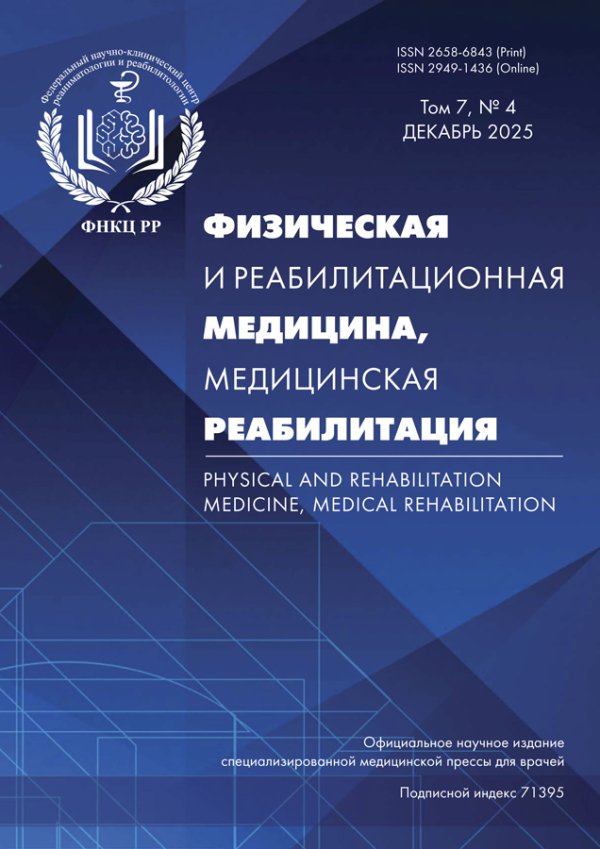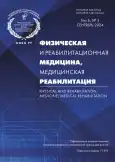Effects of inhaled nitric oxide on endothelial function in patients with ischemic stroke
- Authors: Trofimova A.K.1, Sitenko D.P.1, Ivanova G.E.1
-
Affiliations:
- Federal Center of Brain Research and Neurotechnologies
- Issue: Vol 6, No 3 (2024)
- Pages: 243-252
- Section: ORIGINAL STUDY ARTICLE
- URL: https://journal-vniispk.ru/2658-6843/article/view/269351
- DOI: https://doi.org/10.36425/rehab635422
- ID: 269351
Cite item
Full Text
Abstract
BACKGROUND: A crucial pathogenetic link in the development of stroke is the deterioration of endothelial function, which is a pathological condition characterized by an imbalance between endothelium-dependent relaxing and constricting factors. An example of an endothelium-dependent relaxing factor is nitric oxide, a substance synthesized by the body’s cells that has a vasodilating, antithrombogenic, anti-inflammatory, and antiproliferative effect. Studies have shown the neuroprotective function of inhaled nitric oxide after ischemia; however, determining the minimum effective dose of inhaled nitric oxide in patients who have suffered an acute cerebrovascular accident remains challenging.
AIM: To analyze the protective effect of exogenous nitric oxide using the TIANOX device on the vascular endothelium in patients who have had an ischemic stroke in the early and late recovery period during medical rehabilitation.
MATERIALS AND METHODS: The study involved 21 patients (10 people in the main group, 56.9±8.9 years old, 11 people in the control group, 57.2±8.8 years old) in the early or late recovery period after an ischemic stroke. Patients in the main group underwent an individual medical rehabilitation program and a course of 8–10 inhalations of a gas mixture with nitric oxide at 20 ppm for 20 minutes. Those in the control group underwent an individual rehabilitation course without nitric oxide therapy. Flow-dependent vasodilation of the brachial artery was evaluated to assess endothelial function.
RESULTS: In the main group, a statistically insignificant (p >0.05) increase was found in the diameter of the brachial artery (3.68±0.64 mm), whereas in the control group, this indicator at rest during repeated diagnostics was less than the initial one (3.09±0.87 mm). During repeated diagnostics, the average endothelial shear velocity in patients of the control group increased from 141.53±52.62 to 159.3±82 versus from 143.17±43.53 to 143.48±46.37 in the main group; however, the results were not statistically significant (p=0.753).
CONCLUSION: The increase in the diameter of the brachial artery during flow-dependent vasodilation in patients in the main group may indicate a prosthetic effect of the exogenous form of nitric oxide when using the Tianox device on the vascular endothelium, owing to the possibility of depositing nitric oxide in the body. To confirm the obtained data, a larger sample size of patients is critical in order to further divide the groups of patients into early and late recovery periods after ischemic stroke.
Keywords
Full Text
##article.viewOnOriginalSite##About the authors
Alexandra K. Trofimova
Federal Center of Brain Research and Neurotechnologies
Author for correspondence.
Email: sandratrofimova@gmail.com
ORCID iD: 0000-0001-6521-9503
SPIN-code: 2607-9136
Scopus Author ID: 57210928023
ResearcherId: HGU-1728-2022
Russian Federation, 1/10 Ostrovityanova street, 117513 Moscow
Daria P. Sitenko
Federal Center of Brain Research and Neurotechnologies
Email: dasita11@yandex.ru
ORCID iD: 0009-0006-4526-1206
Russian Federation, 1/10 Ostrovityanova street, 117513 Moscow
Galina E. Ivanova
Federal Center of Brain Research and Neurotechnologies
Email: reabilivanova@mail.ru
ORCID iD: 0000-0003-3180-5525
SPIN-code: 4049-4581
Scopus Author ID: 35825009000
ResearcherId: C-9956-2019
MD, Dr. Sci. (Medicine), Professor
Russian Federation, 1/10 Ostrovityanova street, 117513 MoscowReferences
- Johnson CO, Nguyen M, Roth GA, et al. GBD 2016 Stroke Collaborators. Global, regional, and national burden of stroke, 1990–2016: A systematic analysis for the Global Burden of Disease Study 2016. Lancet Neurol. 2019;18(5):439–458. EDN: BLGFJP doi: 10.1016/S1474- 4422(19)30034-1
- Shechter M, Issachar A, Marai I, et al. Long-term association of brachial artery flow-mediated vasodilation and cardiovascular events in middle-aged subjects with no apparent heart disease. Int J Cardiol. 2009;134(1):52–58. doi: 10.1016/j.ijcard.2008.01.021
- Solovyova AG, Kuznetsova VL, Peretyagin SP, et al. Role of nitric oxide in processes of free radical oxidation. Bulletin Russ Military Med Acad. 2016;1(53):228. EDN: VURZUV
- Malakhov VA, Zavgorodnaya AN, Lichko VS, et al. The problem of nitric oxide in neurology. Kharkiv; 2009. 242 р. (In Russ).
- Griffiths MJ, Evans TW. Inhaled nitric oxide therapy in adults. N Engl J Med. 2005;353(25):2683–2695. doi: 10.1056/NEJMra051884
- Martusevich AK, Ashikhmin SP, Peretyagin SP, Davydyuk AV. Deposited forms of nitric oxide: Biomedical aspects. Vyatskii meditsinskii vestnik. 2014;(3-4):18–24. (In Russ). EDN: TEWNCT
- Pichugin VV, Seifetdinov IR, Medvedev AP, Domnin SE. Inhaled nitric oxide in the prevention of ischemic and reperfusion injuries of the heart during operations with cardiopulmonary bypass. Meditsinskii al’manakh. 2019;(58):81–87. EDN: ZDRIDZ doi: 10.21145/2499-9954-2019-1-81-87
- Terpolilli NA, Kim SW, Thal SC, et al. Inhalation of nitric oxide prevents ischemic brain damage in experimental stroke by selective dilatation of collateral arterioles. Circ Res. 2012;110(5):727–738. EDN: PHPNZJ doi: 10.1161/CIRCRESAHA.111.253419
- Clark RH, Kueser TJ, Walker MW, et al.; Clinical Inhaled Nitric Oxide Research Group. Low-dose nitric oxide therapy for persistent pulmonary hypertension of the newborn. N Engl J Med. 2000;342(7):469–474. doi: 10.1056/NEJM200002173420704
- Bloch KD, Ichinose F, Roberts JD, Zapol WM. Inhaled NO as a therapeutic agent. Cardiovasc Res. 2007;75(2):339–348. EDN: IMXEMF doi: 10.1016/j.cardiores.2007.04.014
- Angelis D, Savani R, Chalak L. Nitric oxide and the brain. Part 1: Mechanisms of regulation, transport and effects on the developing brain. Pediatr Res. 2021;89(4):738–745. doi: 10.1038/s41390-020-1017-0
- Jiang S, Dandu C, Geng X. Clinical application of nitric oxide in ischemia and reperfusion injury: A literature review. Brain Circ. 2020;6(4):248–253. doi: 10.4103/bc.bc_69_20
- Buranov SN, Karelin VI, Selemir VD, et al. The device for inhalation therapy with nitric oxide TIANOX and the first experience of its clinical use in cardiac surgery. Meditsinskii al’manakh. 2018;(4):55. (In Russ). EDN: YRCBVR
- Gadzhieva FG. Individual variety of main arteries of the upper and lower extremities. J Grodno State Med Univer. 2014;(2):105–108. EDN: SGNYCB
- Genkel VV, Salashenko AO, Alexeeva OA, et al. Investigation of endothelial shear rate in patients with atherosclerosis of the carotid arteries. J Atherosclerosis Dyslipidemias. 2016;(2):58–64. EDN: WKFJFD
Supplementary files









